How we reconstructed the courthouse in Smolensk: from laser scans of stucco molding under mold to release
Here in this form we were given it:

The task is to restore the building in legacy form and from legacy materials, and then tightly stuff an engineer and deliver a protected point of contact.
')
The answer to the first obvious question is quite simple: we are not only engaged in hardware and software, but also build intelligent buildings. Usually, of course, we have data centers, trigeneration centers, dispatch centers, emergency centers and other things, where there is more technological filling than concrete. But sometimes we win in competitions for boiler rooms and other objects. Now here is the courthouse, the good construction experience is.
At the entrance we had an architectural project involving the use of materials characteristic of the 37th year. We did everything - from earthworks and strengthening the foundation to the engineer.
We need to start with the fact that the current courthouse during the WWW was the headquarters of the German invaders and at the same time the officer brothel. In the 90s they opened a casino there. Then there was the hotel. Under these cultural strata, we needed to find the Stalin Empire.

Here on this balcony as a whole it is possible to judge how the building lived to our days.
So, at the time of construction (the 37th year), the building was designed in the spirit of constructivism, but quickly redone to a sharply changed standard - the Stalin Empire style.
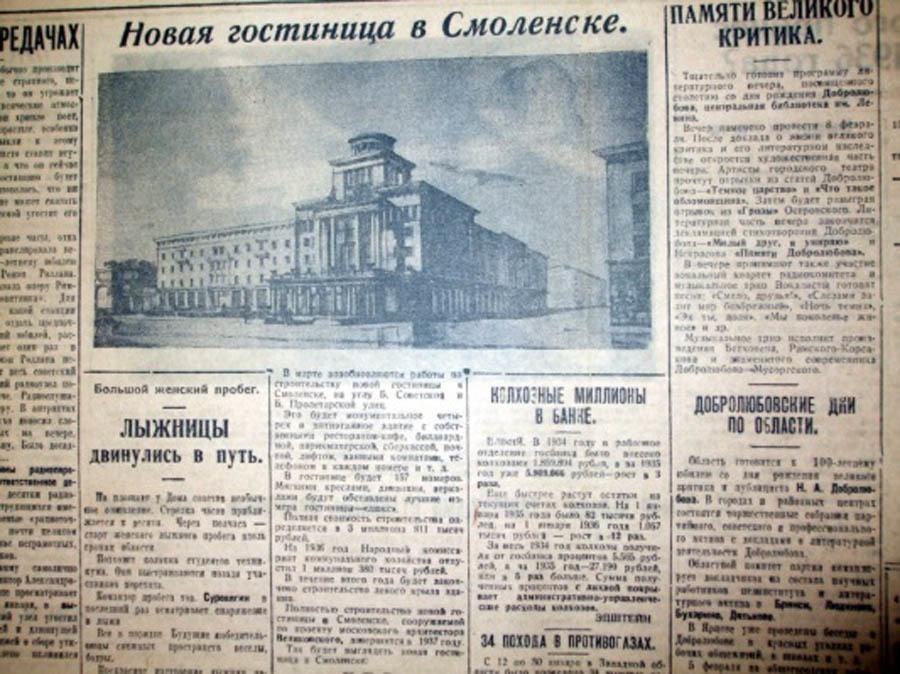

At the time of the beginning of the German occupation, more detailed photographs were preserved. Here is one of them, it's 1942:


The Germans put temporary signs in the city center
Approximately to this kind we needed to roll back the building, at the same time updating everything that had become useless in 80 years.
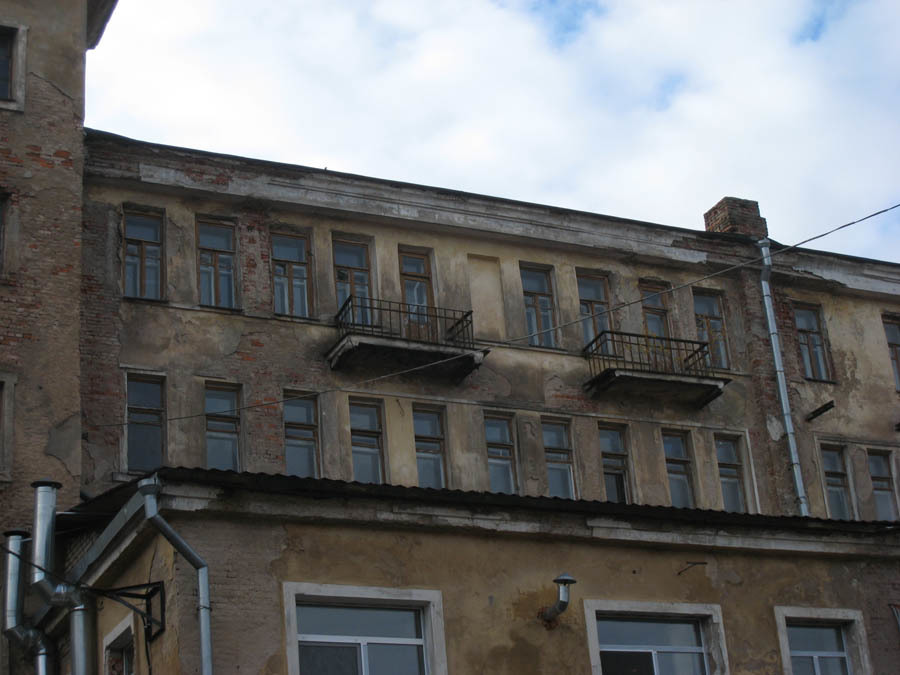
Balcony bearing structures came in disrepair. It was possible to go to the balcony twice - by the number of balconies on the facade.
As I said, in the 40s a German officer corps was formed there. The fact is that in the city after the bombings only two large buildings survived: our own and even the cathedral. Judging by the logs, from 1937 to 2010, 4 major overhauls and a certain amount of cosmetic repairs took place.

The problems concerned mainly the fact that in the 37th year, reinforced concrete still seemed an unreliable and untested new technology, and therefore built classically. That is, from ordinary concrete, which without reinforcement inside has very interesting properties.

Something like this: these are mold stains for decades on load-bearing structures
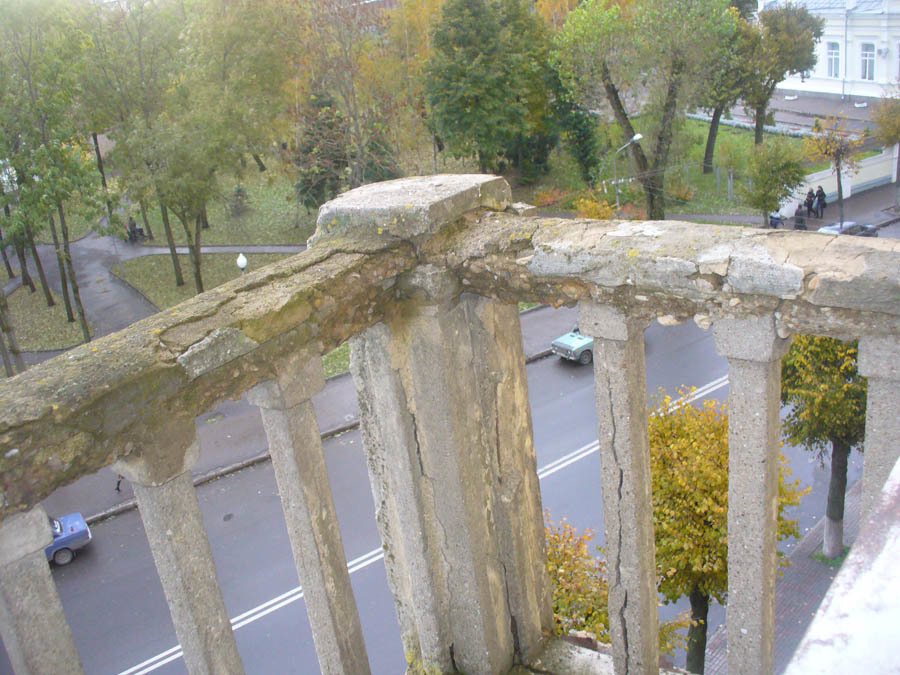
Or like this: emergency condition of balcony enclosures
The architects were able to pick up a variety of historical documents, including some of the drawings (which in itself was not the most trivial task). On their basis, they recalculated the building and prescribed a detailed architectural project, which became an instruction for “broad strokes” what to build from. More precisely, which showed how the building should look as a result, and regulated some of the materials.

Sketch
We had to inspect every inch of the building on site and decide which particular restoration method to apply. At the same time, the task of “modernizing” the building was solved - for example, now the court needs fiber optic, protected cable channels, “some” different heating, a completely different electrician, and so on. To make it clearer - in the years after the electrification of the country, the electric cable was led right along the walls on ceramic round insulators, and, naturally, no one really thought that in 80 years it would be necessary to make communication lines or make false ceiling. The most difficult part was the historical one: the hall and a few more rooms around, which are considered architectural monuments and where nothing extra can be done at all. Even the fire alarm sensors had to be set "long" - so that they began to look at the beam (at the intersection with smoke) because of the "cultural" zone and end it from the other side.
We carefully dismantled what was possible, and then put most of the filling of the building again. Started with the foundation, finished the roof. All floors, columns, walls, all supporting structures, to summarize, they were modernized, strengthened, changed. The whole complex of works on engineering systems: electricity, water supply, ventilation, air conditioning, low current / SCS, access control. The most difficult thing was to restore the building, that is, to give it the look that was conceived in the 37th year. Why is it difficult? Because the devil is in the details. For example, look, there are statues:

The netting of the statue is tied to the facade, so as not to fall on the head of one of the passers-by. That is, of course, at first this statue was anchored with an iron bar:

And then she began to fall apart, and therefore she weighed the net. The original appearance of these statues is nowhere to be found - it is rather difficult to understand how they looked (or should have looked) in the 37th. But the fact that they were known from documents and photographs. Therefore, we carefully dismantled them. What is worse - in the basement, covered with mold, like moss, lay more pieces of statues and stucco. It was necessary to carefully scan each piece on a three-dimensional laser machine, then clean it of mold and fungi, scan more. Then collect what can be called a restored model, then with the help of sculptors cut out new stones from the stone and assemble them in place:
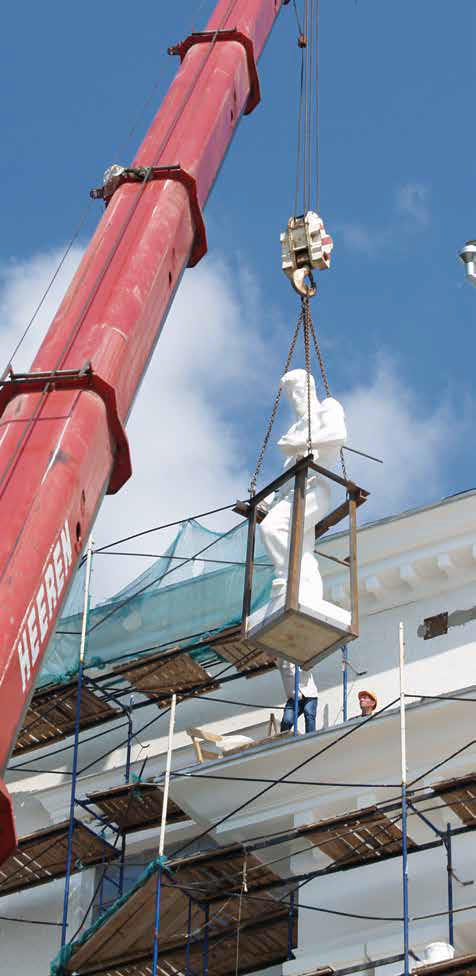
We had two very damaged statues there, which according to the new documents were passed as “collective farmer and collective farmer”. Experts from Penza said that the "kolkhoznitsa" is also a boy, but does something incomprehensible, like a mason. Here it is in the photo. In the old documents - metallurgist and carpenter.
With stucco was more difficult. The fact is that the decor in the conference room (from the very beginning to the end of the hotel’s existence, this hall was the Dnepr restaurant, the main one in the city) was destroyed by the barbarians who opened the casino in the 90s.
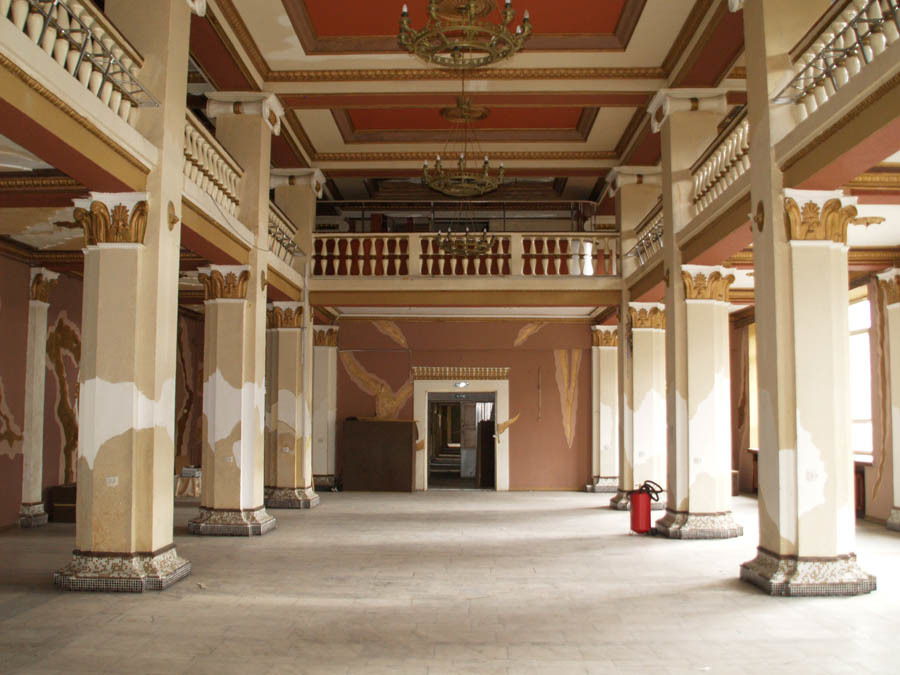
90s, casino times
Acant sheets and pilasters were removed, they were made from them, cast all over again from plaster, brought back. Essentially, restoration is when new technologies are not used, but all the good old things from the 30s are used. There was, of course, a wild desire to make everything from modern polymers. But no, we made it from wood and plaster, because it is necessary. Almost all parts of the halls are replaced. At the main staircase, we put in order fencing structures - we changed half of the balusters (they turned out to be split). Again, each time there were questions, for example: an old oak rail could simply be rejected on the basis of an act (it was cheaper and easier to do a renovation), but we didn’t, instead, we restored it. Unfortunately, it was impossible to recreate the chandeliers - there was no exact evidence, and the eyewitnesses should be more than 90 years to remember more or less. We picked up analogues.

Ionian capital

Chandelier. The screen looks wild in the reconstructed part, but, alas, it was there that one had to put it. Nothing can be done about it.
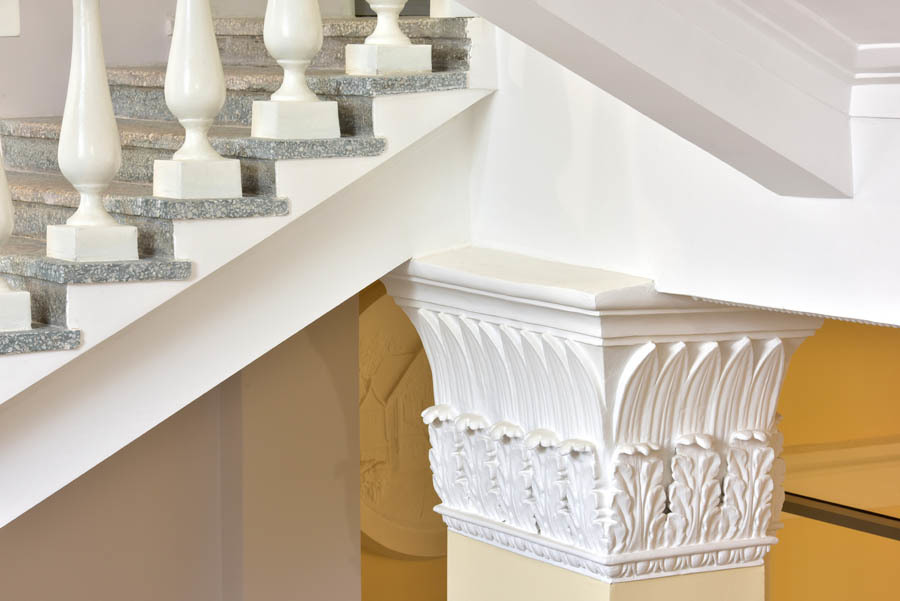
Composite caps with papyrus sheets in the lobby
Each element was not just immediately re-molded, but always coordinated with customers, with local architects and with the department of culture. After that, they received “yes” or comments. If everything was good, then they began to produce. If not, try number two. This applies to all areas of restoration. Most of all, the main representative of the customer delved. Yes, we are incredibly lucky, and he was wildly motivated to help on all issues. Well, or fuck us in all breathing holes, if something went wrong. He appeared at a construction site every day. Carped at everything, demanded to redo everything that there were doubts about. On Fridays it was very interesting to talk about my hometown. He described the history of the detention facility to us and told us what repairs there were in the cells, and that if something was wrong, we would also appreciate it very much. We were afraid, because the subcontractors, of course, mowed down - we worked with them as best we could, but still a couple of unpleasant incidents when we had to disassemble and redo it happened. By the end of the project, the customer clearly saw progress and spoke more about the history of the city, which he knew very well.

Mold on the ceiling of the staircase hall
Let's go back to the building. Some of the materials could still be (and it was necessary for the project) to be replaced with new ones, otherwise they would not fit into modern requirements. For example, instead of wooden floors, they would put reinforced concrete, otherwise a load of 400 kilograms per square meter would have been impossible. The foundation also had to be changed according to the standards - there used to be a bricks, now it has become monolithic.
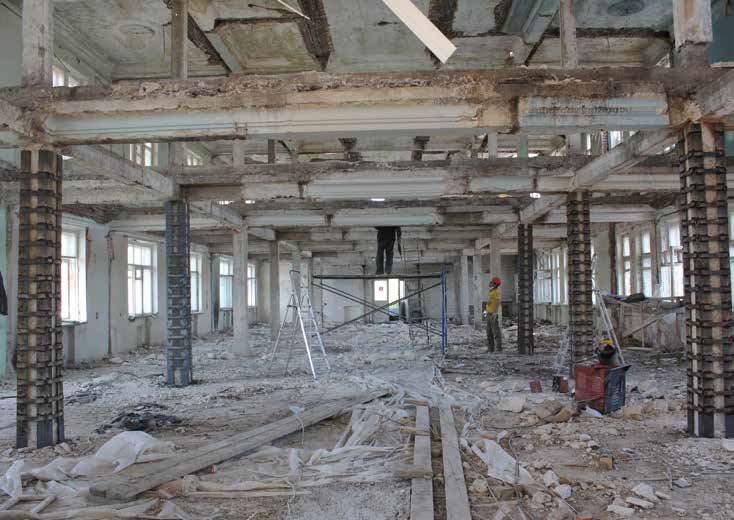
Works
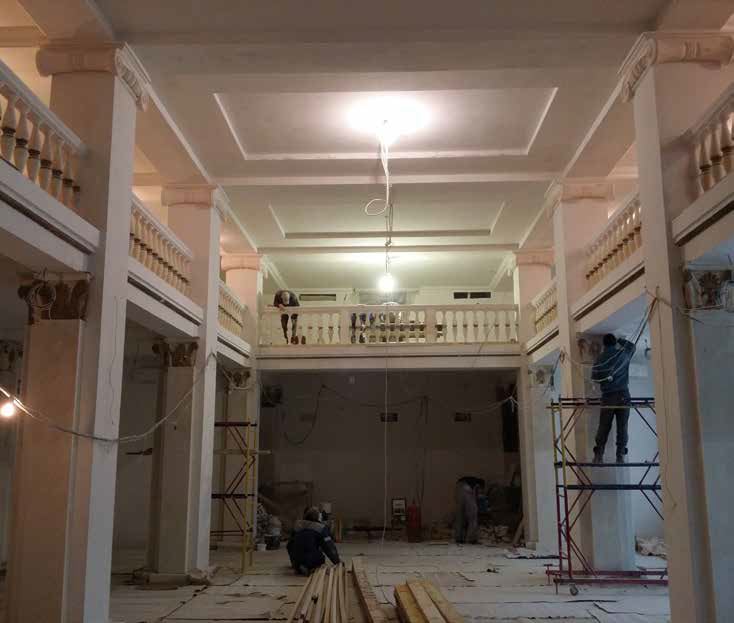
Later
Where a lot of luck, and there were drawings. For example, the battery grille got into the documents, but the stucco in the main hall did not. Paul was destroyed several times - the last time in the 60th was done. We changed for high-quality granite (there used to be chipped slabs) - the architects and cultural scientists decided that this was acceptable.
It was difficult with color, but, fortunately, these questions hardly touched us. In the drawings there is no color, in the photo too (they are black and white), and then the building was broken a couple of times and redone. As a result, the architects gave us the color scheme according to the elements, and if there were any questions, they coordinated with the “culture”. In fact, only the common names of colors were known, plus traces of “archaeological layers” of paint. According to him and restored. For example, here’s how the architect decided on the color of the entrance:
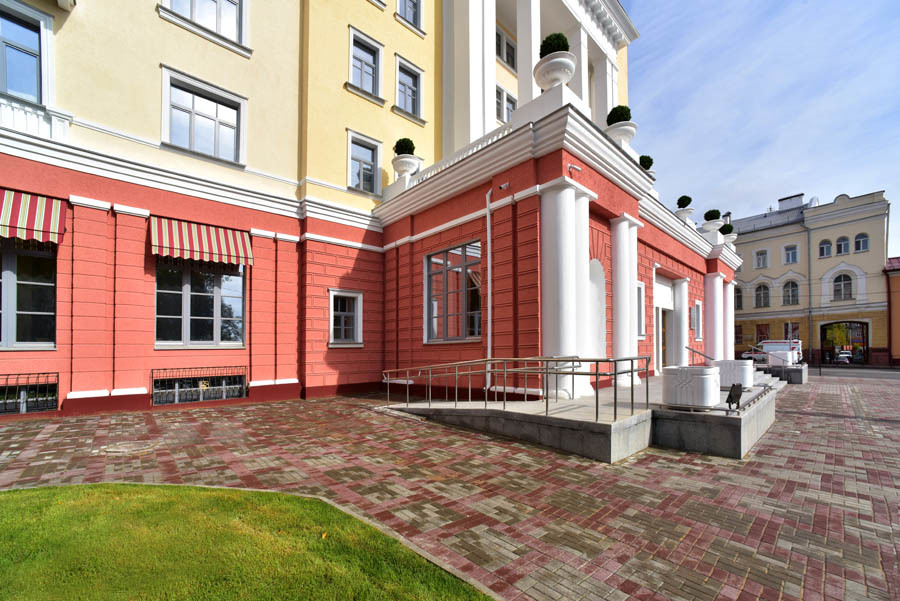
The building was repainted dozens of times due to the specific weather of the region.
Over the years, the facade, of course, will become a little darker. Yes, by the way, the facade is a complete pain. He was here in this form:
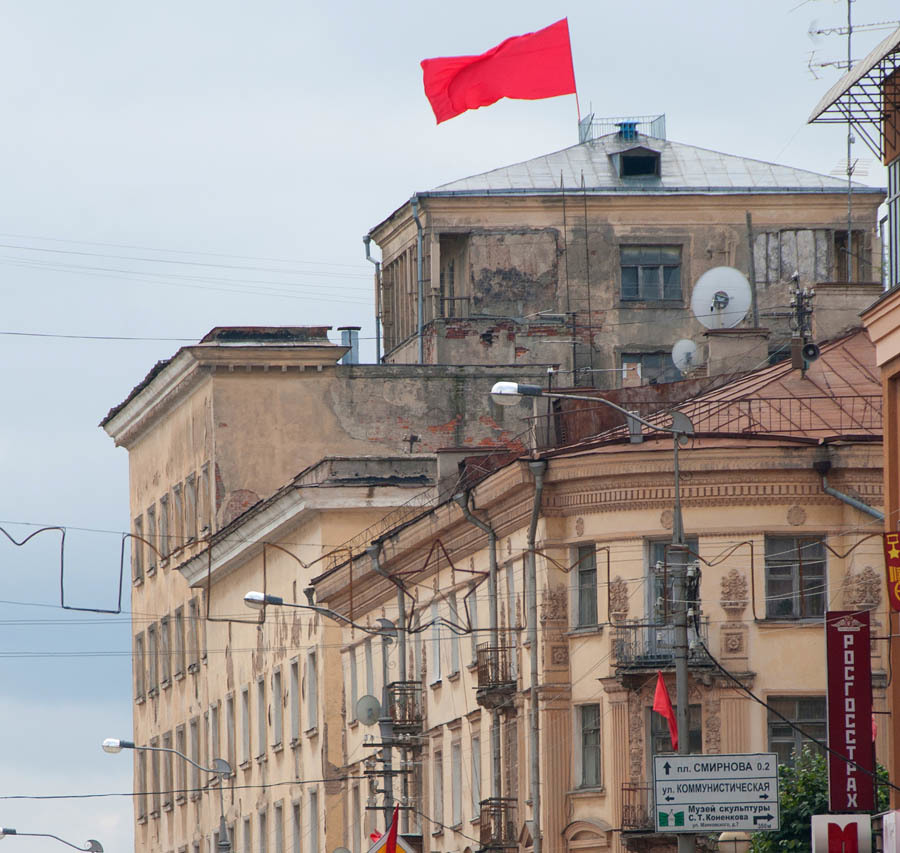
On the day of the city
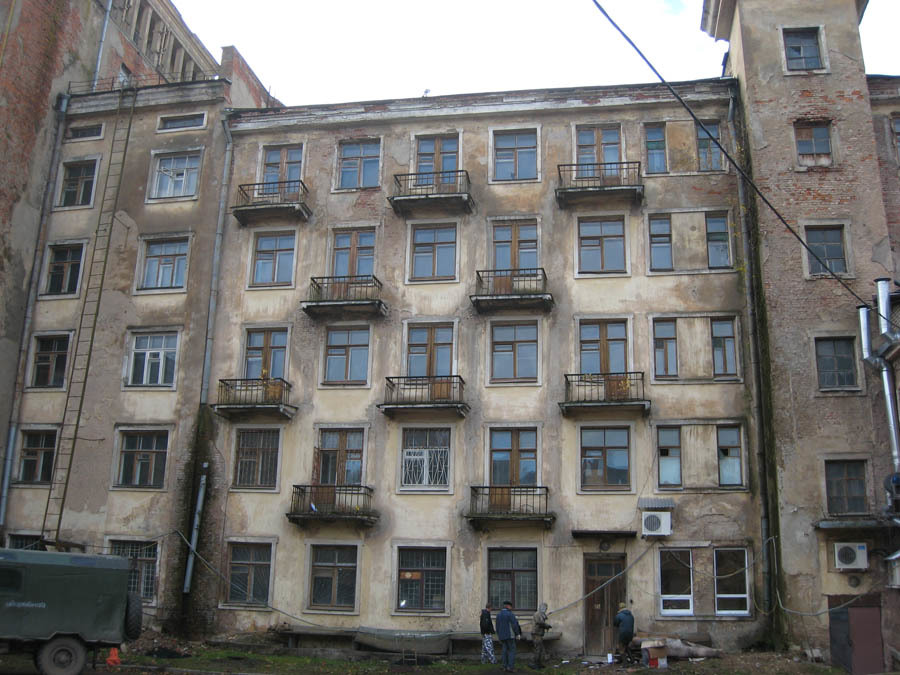
Destruction on the internal facade

The state of interior finishes

More trees
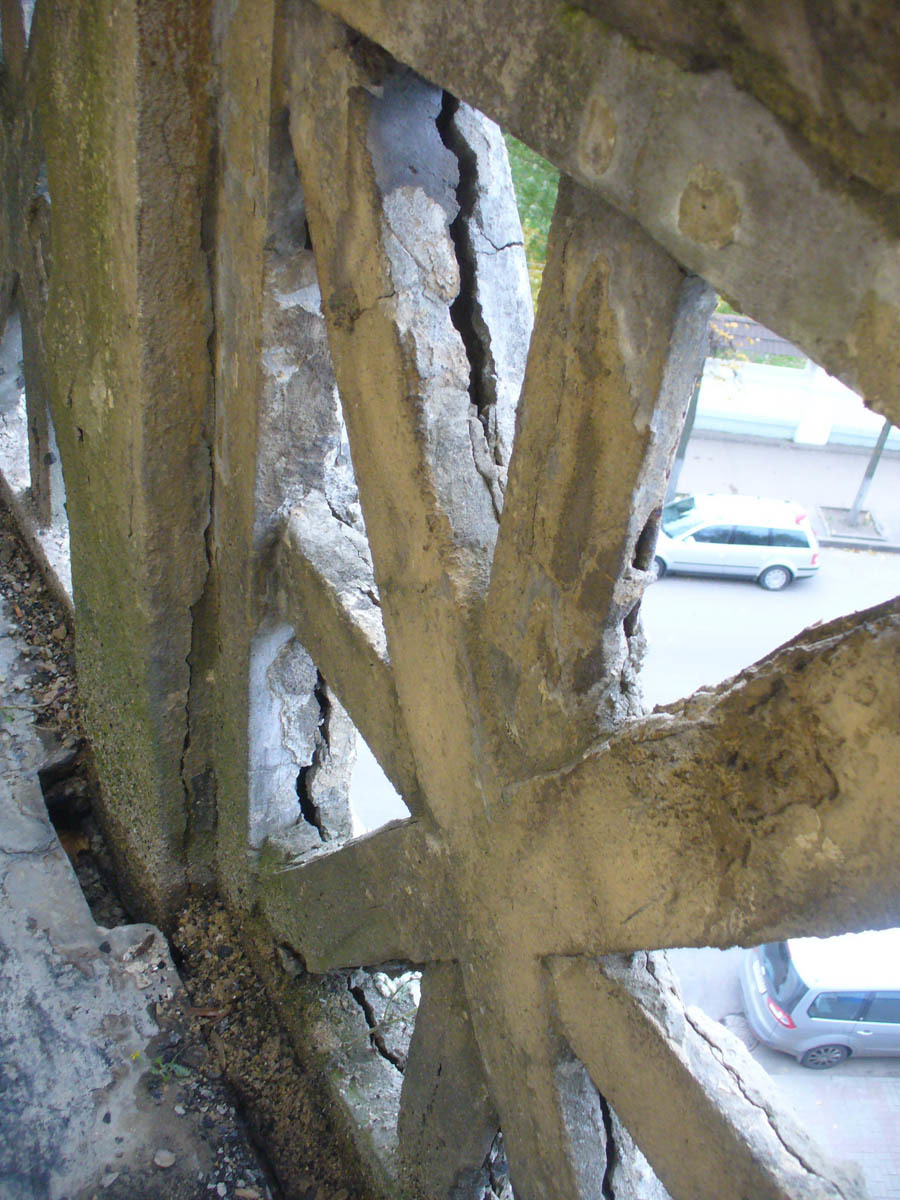
Here and in similar cases, the concrete had to be changed to glass fiber concrete.
The roof flowed - we reworked it several times until it ceased. With it there was a characteristic problem of a lack of theory in the 30s - a difficult angle, the wrong technical decision was made. But this is not a mistake, then it was impossible to err: if you did wrong, then build houses in Siberia. If you recall, the metro station was designed without a computer for 4 weeks. They came from the NKVD and put on a critical deadline: if you do not have time, we will shoot. So, this is a roof - this is not a bug, this is a feature.
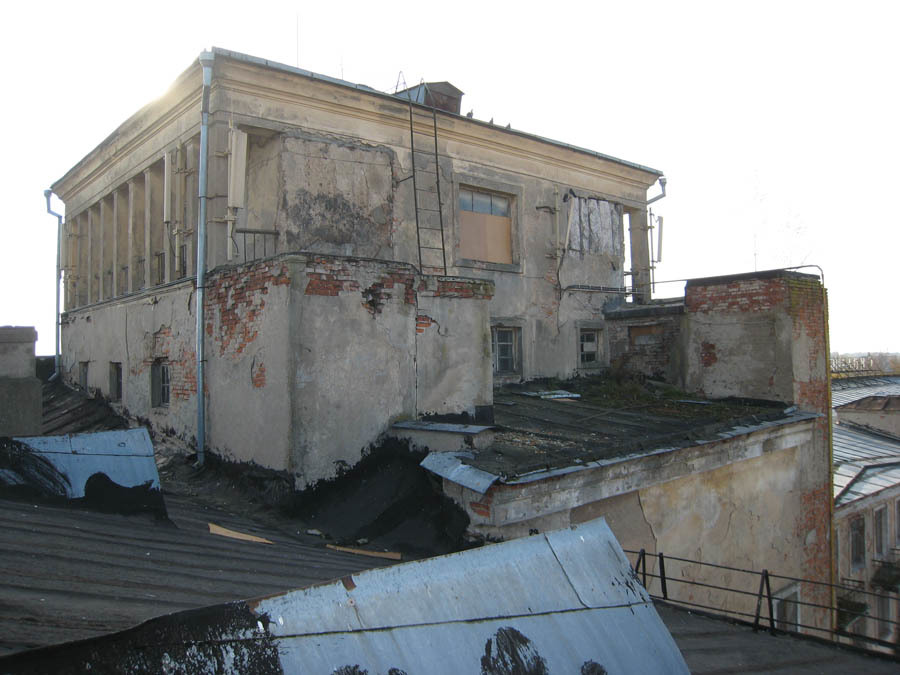
Roof before restoration
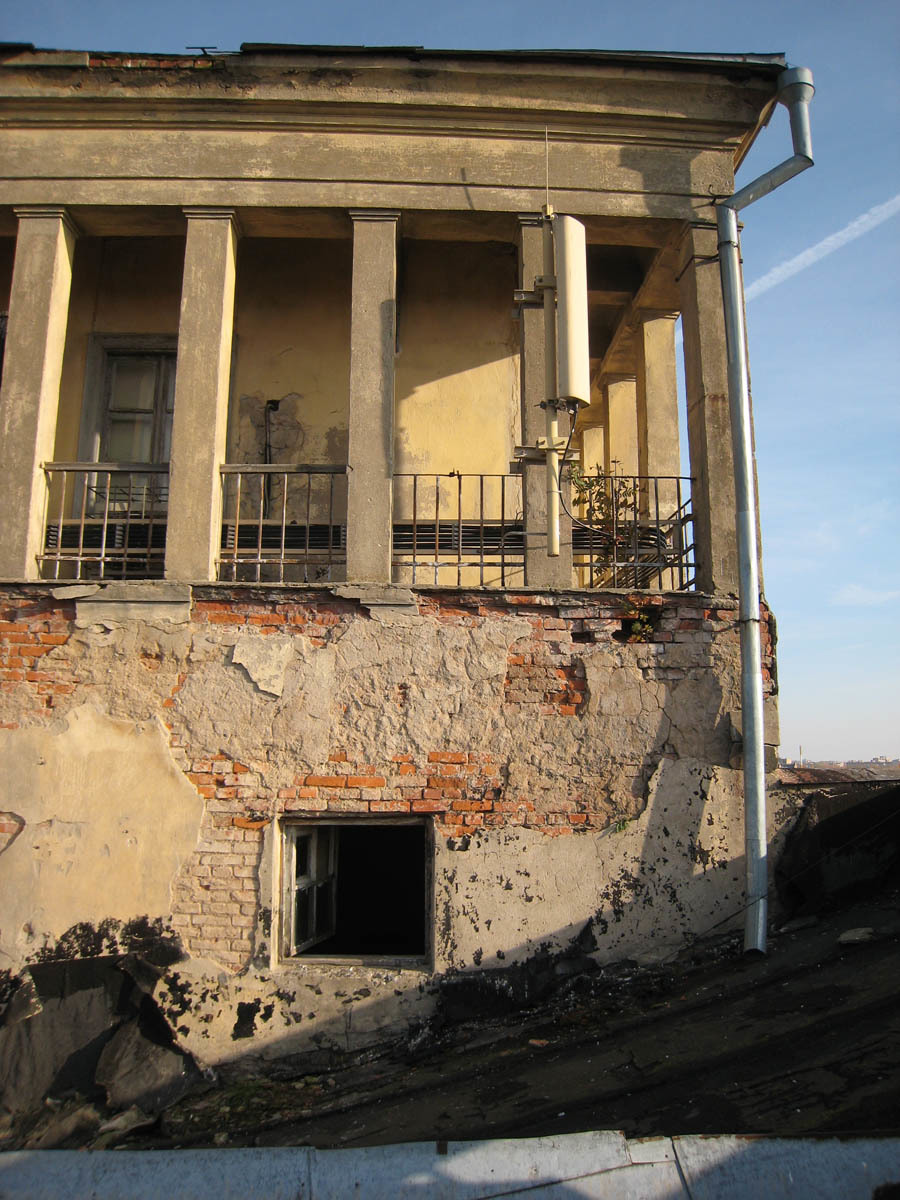
She

Reconstructed roof
Engineering is fun too. At that time, there was no ventilation system. Electricity was - it was open wires on faience fasteners. Heating was done using a local boiler room with built-in stoker. By the way, during the dismantling, we unearthed a coal mine hidden in the folds of the building. Fortunately, without a stoker. More pieces of the casino dug.

That's about

Thermal point before restoration

The engineer even worked. True, not all.
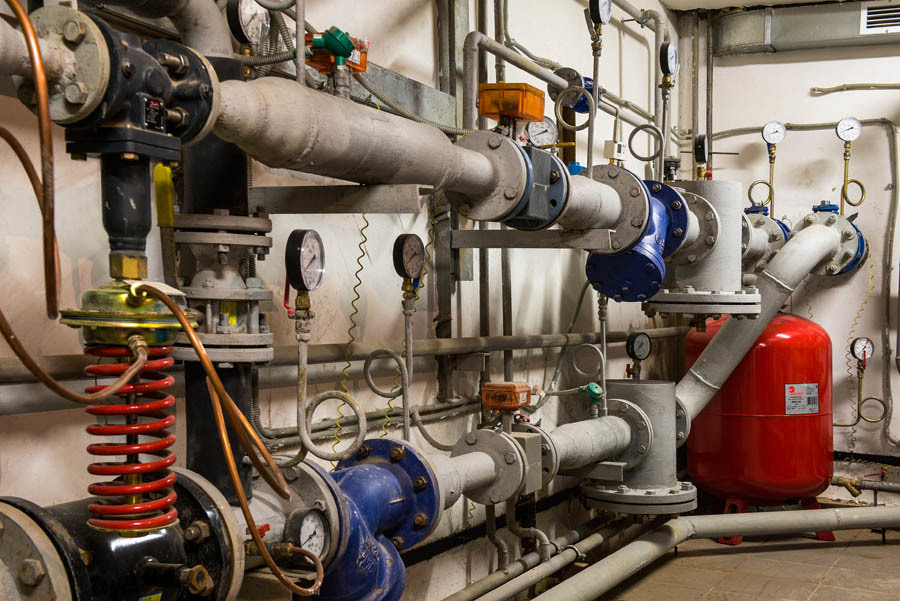
New boiler room

Supply unit
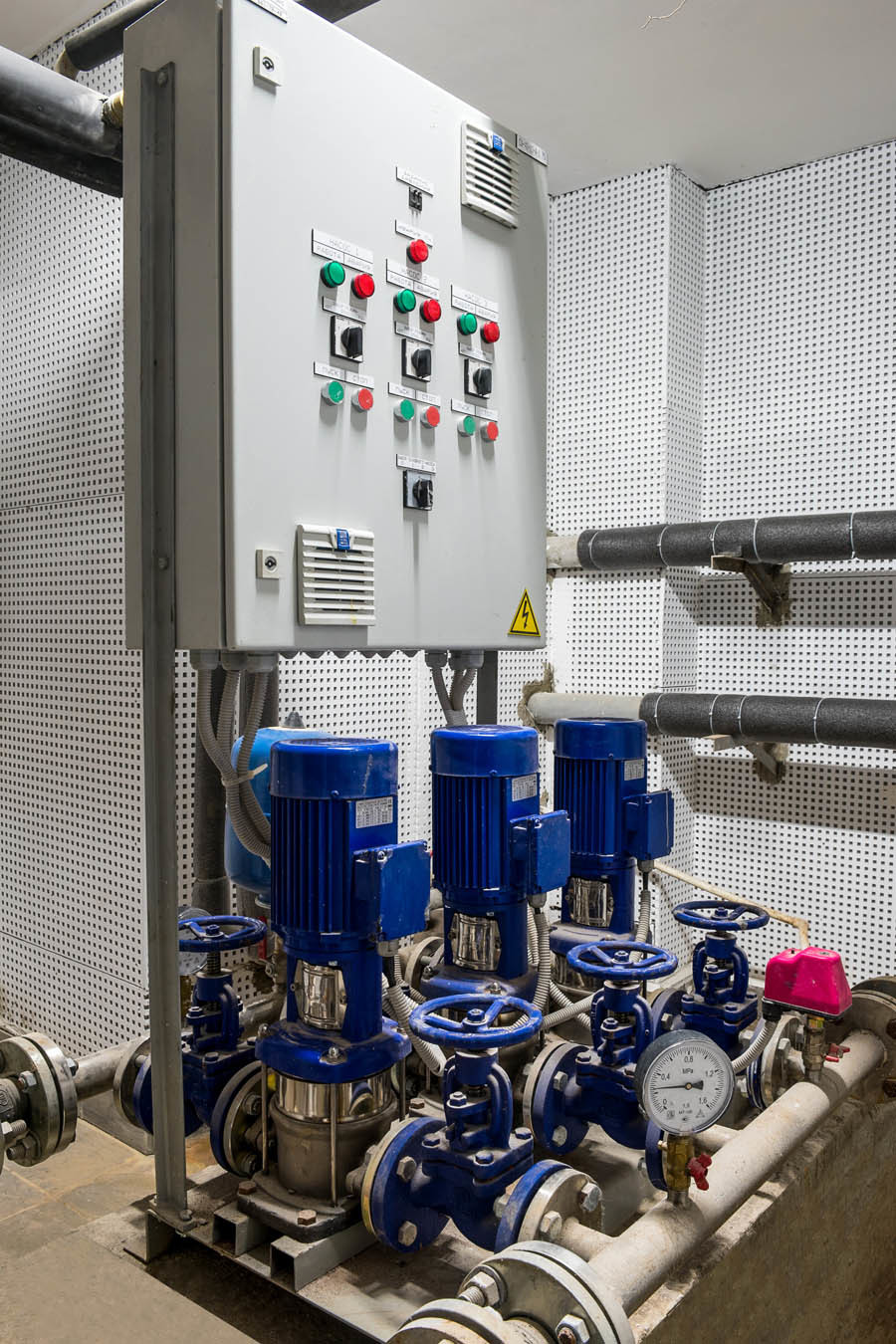
Domestic and drinking water pumping station

Outdoor units of comfortable air conditioning
It was necessary to move away from generally accepted standards in the design of a weak point, yet not an office. In order not to drive highways and highways in the foyer and corridors, we had to make highways in places that were inconvenient for us, but necessary for the building. In the non-historical part they put it behind the ceiling, where it worked. In the historical - basically everything is wireless or miniature. It is a great pity, of course, that the turnstiles of the ACS and the electronic line did not fit into the interior at all, but this is the requirement of our realities.

Main entrance after restoration

Alert, camera, sensor. By the way, the wood was also not treated with impregnations, we processed.

Stairs. It is no accident that the windows are like this: then the main problem of the tree was the fungus, and therefore proper insolation was made everywhere. The window at the top of the head in the Khrushchovka in the bathroom is also for this, so that tuberculosis does not start in your bathroom.

Button
In the modern understanding of intelligence in the building is not enough in comparison with the data center, but, of course, all systems have their own automation and their own logic. Fortunately, the meeting rooms, where you just need a lot of "stuffing" in the walls, are not historical, and everything was simple there.

Meeting Secretary

Hall
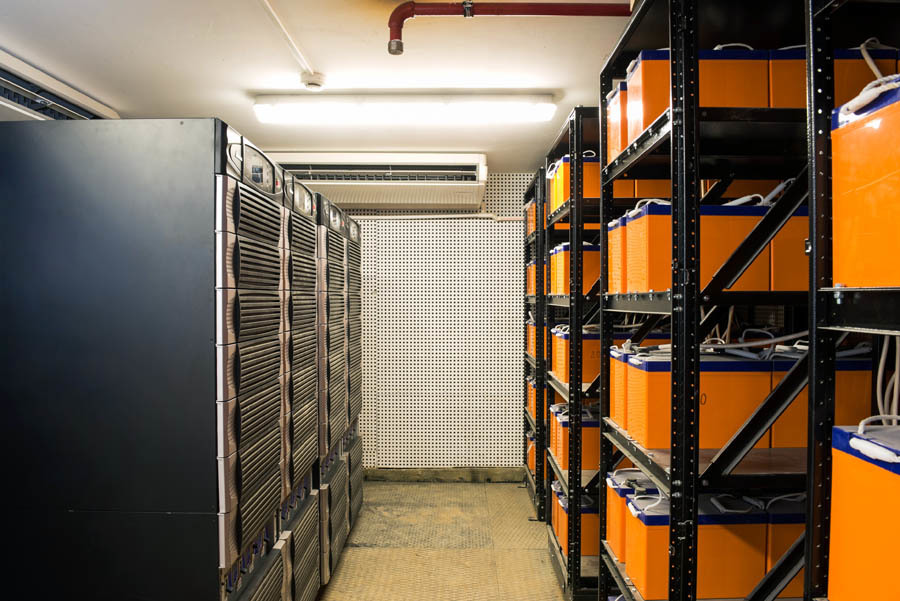
UPS room

Bypass ups
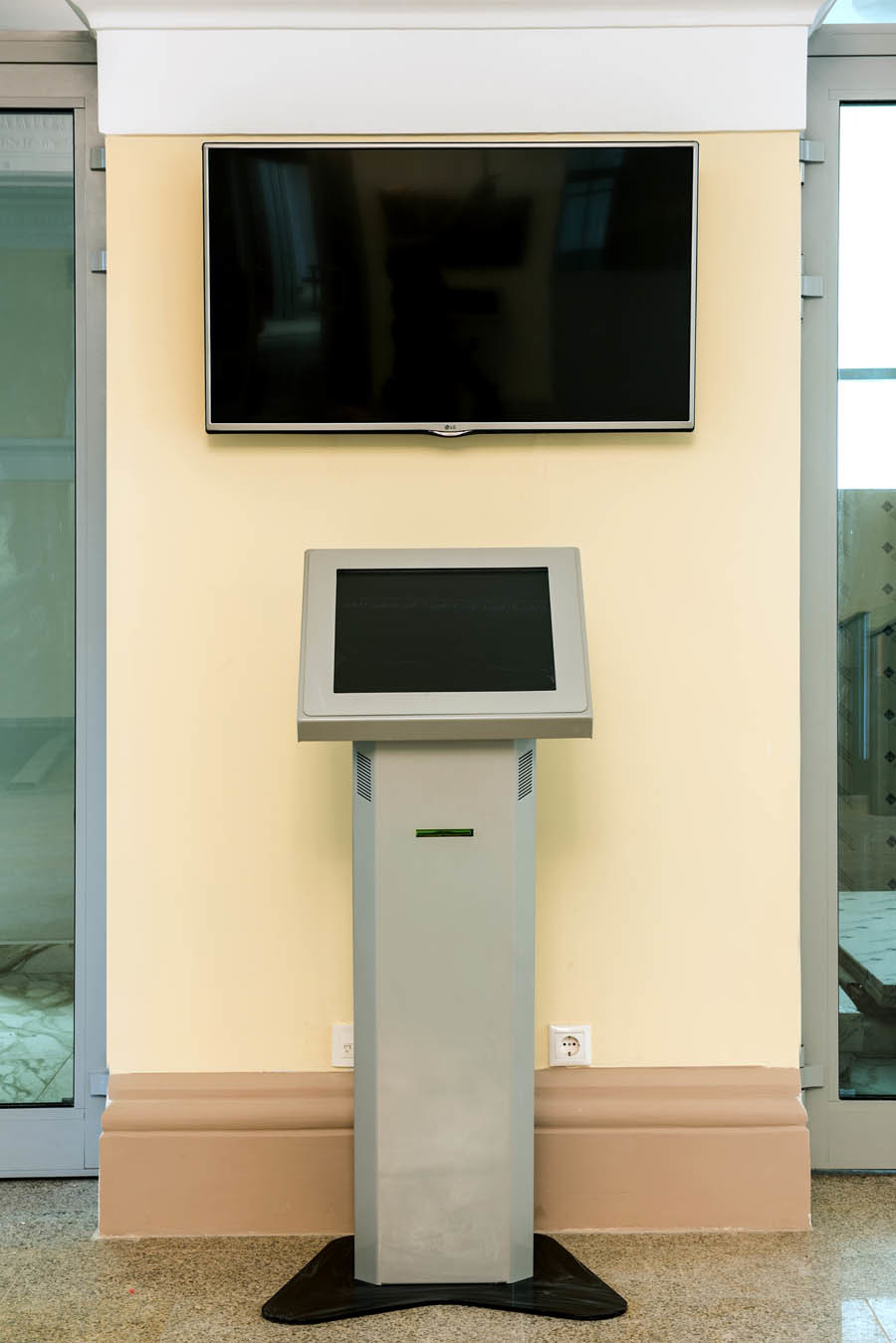
Electronic queue
On the ground floor there is a video conference point (meeting room) for people with limited mobility.
Telemetry of all subsystems is displayed on the control room. Most of the building can be controlled from there, but there is a complete "manual" control of the on-site switches. And another closed part - the one where you can not shoot, about which you can not specifically tell, and where there is a secure connection. There is a little harder.

Architectural lighting
, . . .

Total
. — . , , , , .

The task is to restore the building in legacy form and from legacy materials, and then tightly stuff an engineer and deliver a protected point of contact.
')
The answer to the first obvious question is quite simple: we are not only engaged in hardware and software, but also build intelligent buildings. Usually, of course, we have data centers, trigeneration centers, dispatch centers, emergency centers and other things, where there is more technological filling than concrete. But sometimes we win in competitions for boiler rooms and other objects. Now here is the courthouse, the good construction experience is.
At the entrance we had an architectural project involving the use of materials characteristic of the 37th year. We did everything - from earthworks and strengthening the foundation to the engineer.
We need to start with the fact that the current courthouse during the WWW was the headquarters of the German invaders and at the same time the officer brothel. In the 90s they opened a casino there. Then there was the hotel. Under these cultural strata, we needed to find the Stalin Empire.

Here on this balcony as a whole it is possible to judge how the building lived to our days.
So, at the time of construction (the 37th year), the building was designed in the spirit of constructivism, but quickly redone to a sharply changed standard - the Stalin Empire style.


At the time of the beginning of the German occupation, more detailed photographs were preserved. Here is one of them, it's 1942:


The Germans put temporary signs in the city center
Approximately to this kind we needed to roll back the building, at the same time updating everything that had become useless in 80 years.

Balcony bearing structures came in disrepair. It was possible to go to the balcony twice - by the number of balconies on the facade.
As I said, in the 40s a German officer corps was formed there. The fact is that in the city after the bombings only two large buildings survived: our own and even the cathedral. Judging by the logs, from 1937 to 2010, 4 major overhauls and a certain amount of cosmetic repairs took place.

The problems concerned mainly the fact that in the 37th year, reinforced concrete still seemed an unreliable and untested new technology, and therefore built classically. That is, from ordinary concrete, which without reinforcement inside has very interesting properties.

Something like this: these are mold stains for decades on load-bearing structures

Or like this: emergency condition of balcony enclosures
The architects were able to pick up a variety of historical documents, including some of the drawings (which in itself was not the most trivial task). On their basis, they recalculated the building and prescribed a detailed architectural project, which became an instruction for “broad strokes” what to build from. More precisely, which showed how the building should look as a result, and regulated some of the materials.

Sketch
We had to inspect every inch of the building on site and decide which particular restoration method to apply. At the same time, the task of “modernizing” the building was solved - for example, now the court needs fiber optic, protected cable channels, “some” different heating, a completely different electrician, and so on. To make it clearer - in the years after the electrification of the country, the electric cable was led right along the walls on ceramic round insulators, and, naturally, no one really thought that in 80 years it would be necessary to make communication lines or make false ceiling. The most difficult part was the historical one: the hall and a few more rooms around, which are considered architectural monuments and where nothing extra can be done at all. Even the fire alarm sensors had to be set "long" - so that they began to look at the beam (at the intersection with smoke) because of the "cultural" zone and end it from the other side.
We carefully dismantled what was possible, and then put most of the filling of the building again. Started with the foundation, finished the roof. All floors, columns, walls, all supporting structures, to summarize, they were modernized, strengthened, changed. The whole complex of works on engineering systems: electricity, water supply, ventilation, air conditioning, low current / SCS, access control. The most difficult thing was to restore the building, that is, to give it the look that was conceived in the 37th year. Why is it difficult? Because the devil is in the details. For example, look, there are statues:

The netting of the statue is tied to the facade, so as not to fall on the head of one of the passers-by. That is, of course, at first this statue was anchored with an iron bar:

And then she began to fall apart, and therefore she weighed the net. The original appearance of these statues is nowhere to be found - it is rather difficult to understand how they looked (or should have looked) in the 37th. But the fact that they were known from documents and photographs. Therefore, we carefully dismantled them. What is worse - in the basement, covered with mold, like moss, lay more pieces of statues and stucco. It was necessary to carefully scan each piece on a three-dimensional laser machine, then clean it of mold and fungi, scan more. Then collect what can be called a restored model, then with the help of sculptors cut out new stones from the stone and assemble them in place:

We had two very damaged statues there, which according to the new documents were passed as “collective farmer and collective farmer”. Experts from Penza said that the "kolkhoznitsa" is also a boy, but does something incomprehensible, like a mason. Here it is in the photo. In the old documents - metallurgist and carpenter.
With stucco was more difficult. The fact is that the decor in the conference room (from the very beginning to the end of the hotel’s existence, this hall was the Dnepr restaurant, the main one in the city) was destroyed by the barbarians who opened the casino in the 90s.

90s, casino times
Acant sheets and pilasters were removed, they were made from them, cast all over again from plaster, brought back. Essentially, restoration is when new technologies are not used, but all the good old things from the 30s are used. There was, of course, a wild desire to make everything from modern polymers. But no, we made it from wood and plaster, because it is necessary. Almost all parts of the halls are replaced. At the main staircase, we put in order fencing structures - we changed half of the balusters (they turned out to be split). Again, each time there were questions, for example: an old oak rail could simply be rejected on the basis of an act (it was cheaper and easier to do a renovation), but we didn’t, instead, we restored it. Unfortunately, it was impossible to recreate the chandeliers - there was no exact evidence, and the eyewitnesses should be more than 90 years to remember more or less. We picked up analogues.

Ionian capital

Chandelier. The screen looks wild in the reconstructed part, but, alas, it was there that one had to put it. Nothing can be done about it.

Composite caps with papyrus sheets in the lobby
Each element was not just immediately re-molded, but always coordinated with customers, with local architects and with the department of culture. After that, they received “yes” or comments. If everything was good, then they began to produce. If not, try number two. This applies to all areas of restoration. Most of all, the main representative of the customer delved. Yes, we are incredibly lucky, and he was wildly motivated to help on all issues. Well, or fuck us in all breathing holes, if something went wrong. He appeared at a construction site every day. Carped at everything, demanded to redo everything that there were doubts about. On Fridays it was very interesting to talk about my hometown. He described the history of the detention facility to us and told us what repairs there were in the cells, and that if something was wrong, we would also appreciate it very much. We were afraid, because the subcontractors, of course, mowed down - we worked with them as best we could, but still a couple of unpleasant incidents when we had to disassemble and redo it happened. By the end of the project, the customer clearly saw progress and spoke more about the history of the city, which he knew very well.

Mold on the ceiling of the staircase hall
Let's go back to the building. Some of the materials could still be (and it was necessary for the project) to be replaced with new ones, otherwise they would not fit into modern requirements. For example, instead of wooden floors, they would put reinforced concrete, otherwise a load of 400 kilograms per square meter would have been impossible. The foundation also had to be changed according to the standards - there used to be a bricks, now it has become monolithic.

Works

Later
Where a lot of luck, and there were drawings. For example, the battery grille got into the documents, but the stucco in the main hall did not. Paul was destroyed several times - the last time in the 60th was done. We changed for high-quality granite (there used to be chipped slabs) - the architects and cultural scientists decided that this was acceptable.
It was difficult with color, but, fortunately, these questions hardly touched us. In the drawings there is no color, in the photo too (they are black and white), and then the building was broken a couple of times and redone. As a result, the architects gave us the color scheme according to the elements, and if there were any questions, they coordinated with the “culture”. In fact, only the common names of colors were known, plus traces of “archaeological layers” of paint. According to him and restored. For example, here’s how the architect decided on the color of the entrance:

The building was repainted dozens of times due to the specific weather of the region.
Over the years, the facade, of course, will become a little darker. Yes, by the way, the facade is a complete pain. He was here in this form:

On the day of the city

Destruction on the internal facade

The state of interior finishes

More trees

Here and in similar cases, the concrete had to be changed to glass fiber concrete.
The roof flowed - we reworked it several times until it ceased. With it there was a characteristic problem of a lack of theory in the 30s - a difficult angle, the wrong technical decision was made. But this is not a mistake, then it was impossible to err: if you did wrong, then build houses in Siberia. If you recall, the metro station was designed without a computer for 4 weeks. They came from the NKVD and put on a critical deadline: if you do not have time, we will shoot. So, this is a roof - this is not a bug, this is a feature.

Roof before restoration

She

Reconstructed roof
Engineering is fun too. At that time, there was no ventilation system. Electricity was - it was open wires on faience fasteners. Heating was done using a local boiler room with built-in stoker. By the way, during the dismantling, we unearthed a coal mine hidden in the folds of the building. Fortunately, without a stoker. More pieces of the casino dug.

That's about

Thermal point before restoration

The engineer even worked. True, not all.

New boiler room

Supply unit

Domestic and drinking water pumping station

Outdoor units of comfortable air conditioning
It was necessary to move away from generally accepted standards in the design of a weak point, yet not an office. In order not to drive highways and highways in the foyer and corridors, we had to make highways in places that were inconvenient for us, but necessary for the building. In the non-historical part they put it behind the ceiling, where it worked. In the historical - basically everything is wireless or miniature. It is a great pity, of course, that the turnstiles of the ACS and the electronic line did not fit into the interior at all, but this is the requirement of our realities.

Main entrance after restoration

Alert, camera, sensor. By the way, the wood was also not treated with impregnations, we processed.

Stairs. It is no accident that the windows are like this: then the main problem of the tree was the fungus, and therefore proper insolation was made everywhere. The window at the top of the head in the Khrushchovka in the bathroom is also for this, so that tuberculosis does not start in your bathroom.

Button
In the modern understanding of intelligence in the building is not enough in comparison with the data center, but, of course, all systems have their own automation and their own logic. Fortunately, the meeting rooms, where you just need a lot of "stuffing" in the walls, are not historical, and everything was simple there.

Meeting Secretary

Hall

UPS room

Bypass ups

Electronic queue
On the ground floor there is a video conference point (meeting room) for people with limited mobility.
Telemetry of all subsystems is displayed on the control room. Most of the building can be controlled from there, but there is a complete "manual" control of the on-site switches. And another closed part - the one where you can not shoot, about which you can not specifically tell, and where there is a secure connection. There is a little harder.

Architectural lighting
This is what the engineer did
• AUGP - automatic gas extinguishing installation;
• AUPS - automatic installation of a fire alarm;
• SCS - structured cable system;
• ACS - access control system;
• SOT - security television system;
• zotz - security alarm system;
• SOUE - warning and evacuation control system;
• TS Software and SO - telecommunication network. Software and server hardware;
• TS IVS - telecommunication network of an information computer system;
• SGTS - voice telephone system;
• LMS - queue management system;
• SAF - audio recording system;
• SVKS - audio-video-conferencing system;
• GIS - information protection system.
• AUPS - automatic installation of a fire alarm;
• SCS - structured cable system;
• ACS - access control system;
• SOT - security television system;
• zotz - security alarm system;
• SOUE - warning and evacuation control system;
• TS Software and SO - telecommunication network. Software and server hardware;
• TS IVS - telecommunication network of an information computer system;
• SGTS - voice telephone system;
• LMS - queue management system;
• SAF - audio recording system;
• SVKS - audio-video-conferencing system;
• GIS - information protection system.
Renovation works
1. Replacing wooden floors with monolithic reinforced concrete floors.
2. Replacing existing partitions with new ones.
3. Replacing existing floor coverings with new ones.
4. Replacing existing wooden windows with new wooden windows.
5. Replacing the interior and exterior door units.
6. Replacing balcony ceilings and balcony fences.
7. Restoration of balconies on the street. Great Soviet.
8. Replacing staircases (from the 5th to the 6th floor in axes 8–8´).
9. Repair and restoration of facades with the replacement of existing elements in emergency condition: cornices, sculptures (2 pcs.), Replacement of the plaster layer, painting.
10. The device of the corridor in the attic space above the 5th floor, fenced with fire walls, leading to the staircase in the axes 8-8`.
11. Replacing the roof, truss system; the area and number of dormer windows are determined in accordance with the regulations.
12. Replacing the walls of fiberboard plates on aerated concrete (8th floor).
13. Replacing the external drainage system.
14. Thermal insulation of external walls.
15. Arrangement of additional emergency exits from the 1st floor in the external walls of the courtyard facade and a separate entrance to the pizzeria from the facade on ul. Glinka.
16. Installation of window openings on the 1st floor and basement, installation of an escape exit from the basement in the extension (in axes 1–8, DG), an increase in the window opening on the western facade in the level of the 1st floor
17. The device exits to the roof (8th floor).
18. The separation of the inner central stairs and stairs in axes 1–2 from the adjacent premises with fireproof glazed partitions.
19. Strengthening the supporting structures of the building (walls, columns, foundations).
20. Punching and laying openings in the internal brick walls.
21. Replacing the foundation under the porch of the main entrance with a ramp device for disabled people.
22. Replacement of two elevators in existing mines and the device of a new elevator shaft for an elevator with a cabin depth of 2100 mm.
2. Replacing existing partitions with new ones.
3. Replacing existing floor coverings with new ones.
4. Replacing existing wooden windows with new wooden windows.
5. Replacing the interior and exterior door units.
6. Replacing balcony ceilings and balcony fences.
7. Restoration of balconies on the street. Great Soviet.
8. Replacing staircases (from the 5th to the 6th floor in axes 8–8´).
9. Repair and restoration of facades with the replacement of existing elements in emergency condition: cornices, sculptures (2 pcs.), Replacement of the plaster layer, painting.
10. The device of the corridor in the attic space above the 5th floor, fenced with fire walls, leading to the staircase in the axes 8-8`.
11. Replacing the roof, truss system; the area and number of dormer windows are determined in accordance with the regulations.
12. Replacing the walls of fiberboard plates on aerated concrete (8th floor).
13. Replacing the external drainage system.
14. Thermal insulation of external walls.
15. Arrangement of additional emergency exits from the 1st floor in the external walls of the courtyard facade and a separate entrance to the pizzeria from the facade on ul. Glinka.
16. Installation of window openings on the 1st floor and basement, installation of an escape exit from the basement in the extension (in axes 1–8, DG), an increase in the window opening on the western facade in the level of the 1st floor
17. The device exits to the roof (8th floor).
18. The separation of the inner central stairs and stairs in axes 1–2 from the adjacent premises with fireproof glazed partitions.
19. Strengthening the supporting structures of the building (walls, columns, foundations).
20. Punching and laying openings in the internal brick walls.
21. Replacing the foundation under the porch of the main entrance with a ramp device for disabled people.
22. Replacement of two elevators in existing mines and the device of a new elevator shaft for an elevator with a cabin depth of 2100 mm.
On the porch
1) dismantling of granite blocks, their restoration;
2) the device of new and strengthening of the existing foundations under the porch;
3) restoration of the porch (in terms of the level with a zero mark at the southwest corner) with the return to the place of granite blocks, with the installation of a ramp for the disabled and ensuring the safe lifting of people along the steps.
2) the device of new and strengthening of the existing foundations under the porch;
3) restoration of the porch (in terms of the level with a zero mark at the southwest corner) with the return to the place of granite blocks, with the installation of a ramp for the disabled and ensuring the safe lifting of people along the steps.
On the facade of the main entrance, terrace
1) restoration of vertical and horizontal rustov with frame, portico details, cornice;
2) replacement of the existing window and door blocks with wooden double-glazed windows with historical glass enclosures;
3) replacement of destructed terrace fencing elements;
4) replacement of collapsing flowerpots with identical ones - from more durable material;
5) replacement of a covering of a terrace and drains;
6) the device metal apron over the eaves volume.
2) replacement of the existing window and door blocks with wooden double-glazed windows with historical glass enclosures;
3) replacement of destructed terrace fencing elements;
4) replacement of collapsing flowerpots with identical ones - from more durable material;
5) replacement of a covering of a terrace and drains;
6) the device metal apron over the eaves volume.
On the south (along the Glinka street) facade
1) restoration of reinforced concrete balconies fences;
2) restoration of the architectural details of the porticoes;
3) restoration of rust of the 1st floor;
4) replacement of joinery with wooden double-glazed windows with historical glass enclosures (both window and door);
5) the device of the new central portico covering - with clearing of water intakes and replacement of drainpipes;
6) dismantling of sculptures flanking the central portico, their restoration (or complete replacement, according to the results of diagnostics) and return to the place;
7) replacement of the base of the pedestals of sculptures, strengthening the attachment of sculptures to the masonry;
8) restoration of rust on the facade in the level of 6–7th floors;
9) restoration with the reinforcement of columns in the balustrade of the high-altitude part (8th floor);
10) replacement of balustrade fences;
11) replacement of enclosing structures (wooden frame walls with fibrous filler) of the 8th floor, which are in an unsatisfactory condition, with lightweight foam concrete structures;
12) replacement of joinery with wooden double-glazed windows;
13) the device of the new covering of the crowning cornice and cornice over the rusticated part, as well as parapets over the cornices;
14) metal flagpole on the roof of the 8th floor to use as lightning protection;
15) a separate entrance to the pizzeria from the facade on the street. Glinka.
2) restoration of the architectural details of the porticoes;
3) restoration of rust of the 1st floor;
4) replacement of joinery with wooden double-glazed windows with historical glass enclosures (both window and door);
5) the device of the new central portico covering - with clearing of water intakes and replacement of drainpipes;
6) dismantling of sculptures flanking the central portico, their restoration (or complete replacement, according to the results of diagnostics) and return to the place;
7) replacement of the base of the pedestals of sculptures, strengthening the attachment of sculptures to the masonry;
8) restoration of rust on the facade in the level of 6–7th floors;
9) restoration with the reinforcement of columns in the balustrade of the high-altitude part (8th floor);
10) replacement of balustrade fences;
11) replacement of enclosing structures (wooden frame walls with fibrous filler) of the 8th floor, which are in an unsatisfactory condition, with lightweight foam concrete structures;
12) replacement of joinery with wooden double-glazed windows;
13) the device of the new covering of the crowning cornice and cornice over the rusticated part, as well as parapets over the cornices;
14) metal flagpole on the roof of the 8th floor to use as lightning protection;
15) a separate entrance to the pizzeria from the facade on the street. Glinka.
On the east (on the Bolshaya Sovetskaya street) facade
1) restoration of balconies, identical to the balconies on the southern facade, with the establishment of consoles in the preserved nests;
2) restoration of rust of the 1st floor;
3) ;
4) 1- , .
2) restoration of rust of the 1st floor;
3) ;
4) 1- , .
1) 1- , 5- ;
2) ;
3) 5- ;
4) , , 1- ;
5) 1- -``.
2) ;
3) 5- ;
4) , , 1- ;
5) 1- -``.
1) , 16;
2) ;
3) ;
4) 6–5 4–3 5- ;
5) ;
6) 14–16;
7) :
• 1- 14–16 ;
• 8–8' — ;
• ;
• .
2) ;
3) ;
4) 6–5 4–3 5- ;
5) ;
6) 14–16;
7) :
• 1- 14–16 ;
• 8–8' — ;
• ;
• .
1–8, -`
1) 1- , ;
2) .
2) .
, . . .

Total
. — . , , , , .
Links
Source: https://habr.com/ru/post/323044/
All Articles